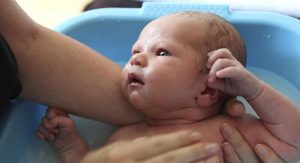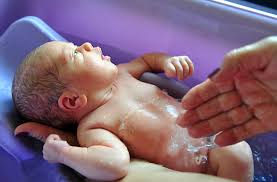Bathing a newborn baby for the first time often brings out feelings of anxiety in new parents. As a former NICU/Special Care Nurse, I saw this all the time. The practice of post-natal midwives and nurses should be: show one, assist one then supervise one. Unfortunately, this doesn’t always happen for various reasons so I have a step-by-step guide as well as some dos and don’ts as a general reference. However, please make sure you follow any advice or instructions given to you by health care professionals over this information.

It is important to remember that babies needs and wants vary. Especially when it comes to things like sleep patterns, likes and dislikes. We often think babies hate baths but the fact is most of them find it relaxing and enjoyable. The part they don’t like is the undressing and then removal from the nice warm water. Once in that warm water the crying can often stop and the baby will look and feel contented. That’s why it is best to bath baby in the evening just before their evening feed then bedtime. It will take some time to work out your baby’s routines so use the evening as guide at first and choose a time when you will be less likely to have distractions.
Something I always advocate is minimal use of soaps and especially bubble bath. It might make you feel good to clean you baby with something sudsy as that is what we think cleans the best. The fact is, babies don’t need suds and their fragile skin can be made even drier because of them. You know what it’s like having dry, flaky skin and scratching, feeling uncomfortable. Imagine how uncomfortable that would feel if you were a tiny baby not capable of scratching! Also avoid scented creams and lotions. If your baby has dry skin then a little sorbolene or zinc and castor oil is very good and a lovely way to gently massage them at the same time. This is a great relaxation technique.
DO
- Prepare everything you will need before you even touch the baby.
- Plan bath time just before sleep time. Preferable in the evening to enhance longer sleeping period.
- Use a plastic baby bath on a table or the sink. Working at waste height makes it easier and safer.
- Only use water and maybe bath oil specifically designed for babies. They don’t need soap at this young age.
- Remove your watch and any rough jewellery like engagement rings.
- Wash your hands
- Ensure water temperature is around 36°C
DON’T
- Never ever use soap on the face!
- Shampoo is unnecessary for babies’ hair.
- Do not get distracted and walk away from the baby when he/she is in the bath. Babies can drown in as little as a couple of centimetres of water.
- NEVER use talcum (baby) powder. Not only is it unnecessary it is potentially harmful and will clog their pores.
- Don’t rub or dry your baby vigorously.

STEP-BY-STEP GUIDE
- Choose a time when you are likely to experience the least amount of distractions.
- Put your phone on silent and even leave it in another room so you are not tempted to look at it while bathing.
- Prepare all the equipment and items you will need including, clothes, towels, bath, etc.
- Close any doors and/or windows to prevent drafts. Keep a heater on nearby if the house is cold or its winter time.
- Fill tub or sink with warm water 36°C
- Place a cloth or towel into the bath for baby to rest on to prevent slipping.
- Using cotton balls and warm water, clean the baby’s face and eyes. Make sure you use a separate cotton ball for each eye and wipe from the inner eyelid outwards.
- Test water with your wrist before you place baby into it.
- If you are washing baby’s hair, remove their clothes except nappy and wrap them in a towel. Hold baby with one hand/arm over the water and use your other hand to wash their head and hair
- Then dry their head before you continue. (This prevents them from getting cold as they lose a lot of body heat from their head and face. Don’t let them sit in a bath with a wet head exposed to the air for more than a few minutes.
- Cradle your baby’s head with one hand, supporting the back and neck with the other arm. Gently lower them into the bath, feet first, keeping a close hold at all times.
- Supporting his/her head, gently splash water over their body using your hand or a washcloth.
- Wash from clean to dirty areas. E.g. wash hands and arms, legs and feet then leave genitals and bottom to last.
- You might like to move baby back and forward in the water gently to sooth them after washing. Or put them onto the prone support (if you have one) and trickle water onto their back.
- Remove baby from the bath onto a towel and dry. Try not to rub vigorously but make sure areas with skin creases are not left wet.
- Get that nappy on ASAP!
- Apply cream sparingly and gently massage into skin. Again, avoiding face and eyes.
- Remember babies put their hands in their mouths all the time so try not to apply creams and ointments onto hands.
- Dress the baby and then feed before putting him/her down to sleep.
